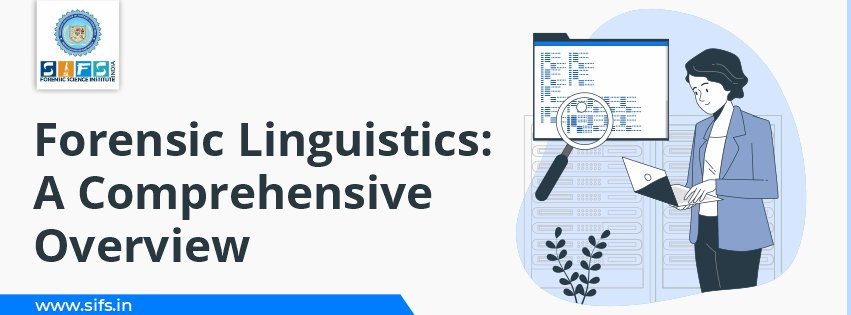- Call Us: +91 7303913002
- Email Us: education@sifs.in
Forensic Linguistics: A Comprehensive Overview

BY SIFS India | November 24, 2024
Forensic Linguistics: A Comprehensive Overview
Forensic linguistics is a fascinating field that merges language and law. It plays a critical role in solving crimes, ensuring justice, and understanding the power of words. Whether it's analyzing ransom notes or assessing witness statements, forensic linguistics contributes to various legal scenarios. Let’s dive into this intriguing discipline and explore its scope, applications, and importance.
What is Forensic Linguistics?
Forensic linguistics is the application of linguistic knowledge, methods, and insights to legal contexts. It involves analyzing written or spoken language evidence to solve legal issues or disputes. From identifying authorship to detecting deception, forensic linguists unravel mysteries hidden in communication.
Key Areas of Forensic Linguistics
Forensic linguistics covers a broad spectrum of activities. Here are some of its primary areas:
Authorship Identification: Determining the author of a text is a common task for forensic linguists. By examining writing style, vocabulary, syntax, and grammatical patterns, experts can often pinpoint who wrote a document.
Applications: Ransom notes, anonymous letters, and legal documents.
Voice Identification: Forensic linguists analyze speech to identify individuals, especially in cases involving audio recordings.
Factors considered: Accent, pitch, tone, and speech patterns.
Discourse Analysis: This involves examining how language is used in communication, such as in courtroom testimony, police interviews, or recorded conversations.
Goal: Identify inconsistencies, coercion, or manipulation in speech.
Translation and Interpretation Issues: Forensic linguists ensure accurate translations in multilingual legal cases to avoid misinterpretation.
Contexts: International disputes, immigration cases, and multilingual contracts.
Trademark Disputes: Analyzing the linguistic features of brand names and slogans to determine uniqueness or infringement.
Example: Deciding if a new product name is too similar to an existing one.
The Role of Forensic Linguists in Criminal Cases
Forensic linguists often assist law enforcement, lawyers, and courts. Here’s how they contribute:
Analyzing Threatening Communications: Identifying patterns in threatening letters or emails to trace the author.
Examining Confessions: Ensuring confessions were obtained legally and without coercion.
Deciphering Code Language: Breaking down coded or cryptic messages used by criminals.
Assessing Witness Credibility: Analyzing linguistic clues to verify truthfulness in testimony.
Tools and Techniques in Forensic Linguistics
Forensic linguists employ various tools and techniques to analyze language. Some of these include:
Corpus Analysis: Using large databases of text (corpora) to compare linguistic patterns.
Stylometry: Measuring writing style through metrics like word frequency and sentence structure.
Phonetic Analysis: Studying sound patterns in spoken language.
Machine Learning Tools: Leveraging AI to analyze vast amounts of linguistic data quickly.
Famous Cases Solved by Forensic Linguistics
The practical importance of forensic linguistics is highlighted by its success in solving high-profile cases.
Unabomber Case: The manifesto of the Unabomber was analyzed linguistically, leading to the identification of Ted Kaczynski. His unique writing style matched earlier communications.
JK Rowling’s Pseudonym Discovery: When Rowling published a book under the pseudonym Robert Galbraith, forensic linguistics helped reveal her identity by comparing her writing style with her known works.
911 Call Analysis: In some cases, the language used during emergency calls has been analyzed to detect deception or guilt.
Challenges in Forensic Linguistics
While forensic linguistics is highly effective, it comes with its challenges:
Subjectivity: Interpretation of language can sometimes vary among experts.
Cultural and Dialectical Differences: Variations in language use across regions can complicate analysis.
Limited Data: Sometimes, there isn’t enough language evidence to draw definitive conclusions.
Why Forensic Linguistics Matters?
Forensic linguistics goes beyond solving crimes—it helps uphold justice, prevent fraud, and ensure fair trials. It also sheds light on how language can be weaponized or misunderstood in legal contexts.
Key Benefits:
- Enhances the reliability of evidence in court.
- Supports law enforcement in criminal investigations.
- Protects individuals from false accusations.
- Careers in Forensic Linguistics
If this field intrigues you, here’s what a career in forensic linguistics might look like:
Skills Required:
- Proficiency in linguistics and law.
- Attention to detail and analytical thinking.
- Knowledge of software for linguistic analysis.
- Typical Job Roles:
- Expert Witness in Courts
- Consultant for Law Enforcement Agencies
- Academic Researcher
- Private Investigator Specializing in Language
Pathway to the Field:
- Earn a degree in linguistics, forensic science, or criminal justice.
- Pursue specialized training in forensic linguistics.
- Gain practical experience through internships or research projects.
The Future of Forensic Linguistics
The field is evolving rapidly, thanks to technological advancements. Machine learning and artificial intelligence are increasingly integrated into linguistic analysis, making processes faster and more accurate. As cybercrime and digital communication grow, forensic linguistics will remain a crucial tool in combating new-age crimes.
Conclusion
Forensic linguistics bridges the gap between language and law, offering invaluable insights into complex legal cases. Its applications range from solving crimes to resolving civil disputes, showcasing its versatility and importance. With the continuous development of tools and techniques, the field promises a bright future in the pursuit of justice.
Whether you are a budding linguist or just fascinated by the power of words, forensic linguistics opens a window into the intricate ways language influences our legal systems.

